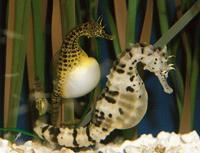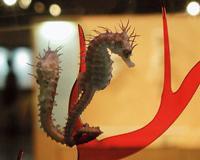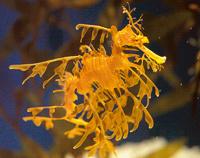Sea horses: the ‘pregnant’ father
2005/10/01 Kortabitarte Egiguren, Irati - Elhuyar Zientzia Iturria: Elhuyar aldizkaria

Indeed. The reproduction of the marine horse is very curious; after the procession of males and females, the female deposits the eggs in the ventral bag of the male. There they remain for three or four weeks until the birth of the offspring. The male sea horse has a pouch similar to that of the kangaroo. At the time, the
female lays 200 eggs in her partner's bag in a single session. In the bag of the male sea horse fit about 600 eggs. However, normally a single female cannot fill the bag.
During the following month the young grow safely inside the bag. When the time of birth comes, the seahorse anchors on the stem of a seaweed. It then swings to help the offspring get out of the bag. In this process, the natural color of the male sea horse changes radically becoming grayish white. After the birth of the young, they rise to the surface and, filling the swim bladder with air, they stand for the first time. Since then you will live in that attitude.

And that is another peculiarity of the marine horse. Most fish swim with their heads ahead. But the sea horse swims with its head raised. Small pectoral fins help you move transversely. The tail, on the other hand, allows to retain the algae so as not to drag the waters or hide them from possible predators. In fact, the marine horse lives near the coast, where algae abound.
Its appearance is not as fragile as it seems. Its bark is hard and serves to defend itself from enemies as if it were an armor. Therefore, although it seems very weak and fragile, its outer coverage is hard.
The eyes of the sea horse do not move at the same time, use one eye to hunt and spy with the other to see when the enemy comes. Tail rolled like that of monkeys. And when you want to eat or rest, a piece of coral or algae is held with the tail.

a dragon shaped marine horse, native to Australia, very special. Protected species. Thus, authorized persons can also capture a single male a year. It is what you will later have. It is very sensitive to strong light changes. This unique marine horse can be seen in the Barcelona aquarium.
The marine horse is very abundant, having identified about fifty species worldwide. In 1829 he first classified the barons of Cuvie. Almost all belong to the genus Hippocampus. In the Mediterranean the most abundant species is the Hippocampus guttulatus. It has an approximate length of fifteen centimeters and a long end.
Despite its abundance, in many parts of the world there is a high risk of disappearance of the marine horse, whose habitat is in poor condition. In Asia twenty million marine horses are fished annually, including Chinese medicine, and mass fishing, in addition to the number of local species, has endangered the extinction of the species.
Every mature marine horse can make thousands of young, but the mortality of marine horses is very high when they are fry; approximately 5% of the young survive in the sea.



